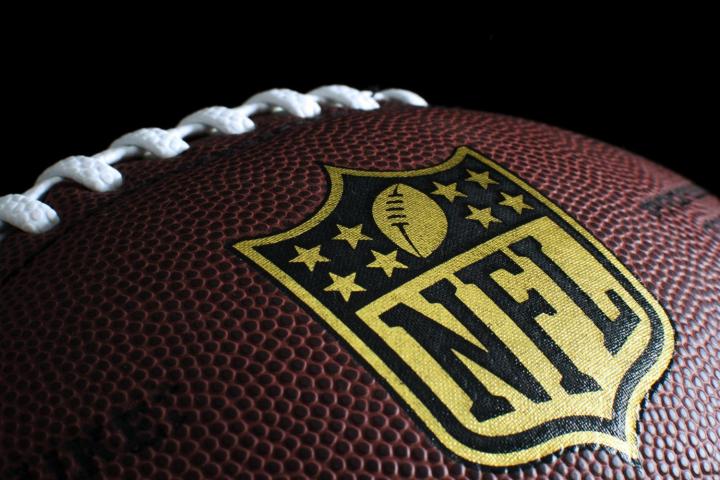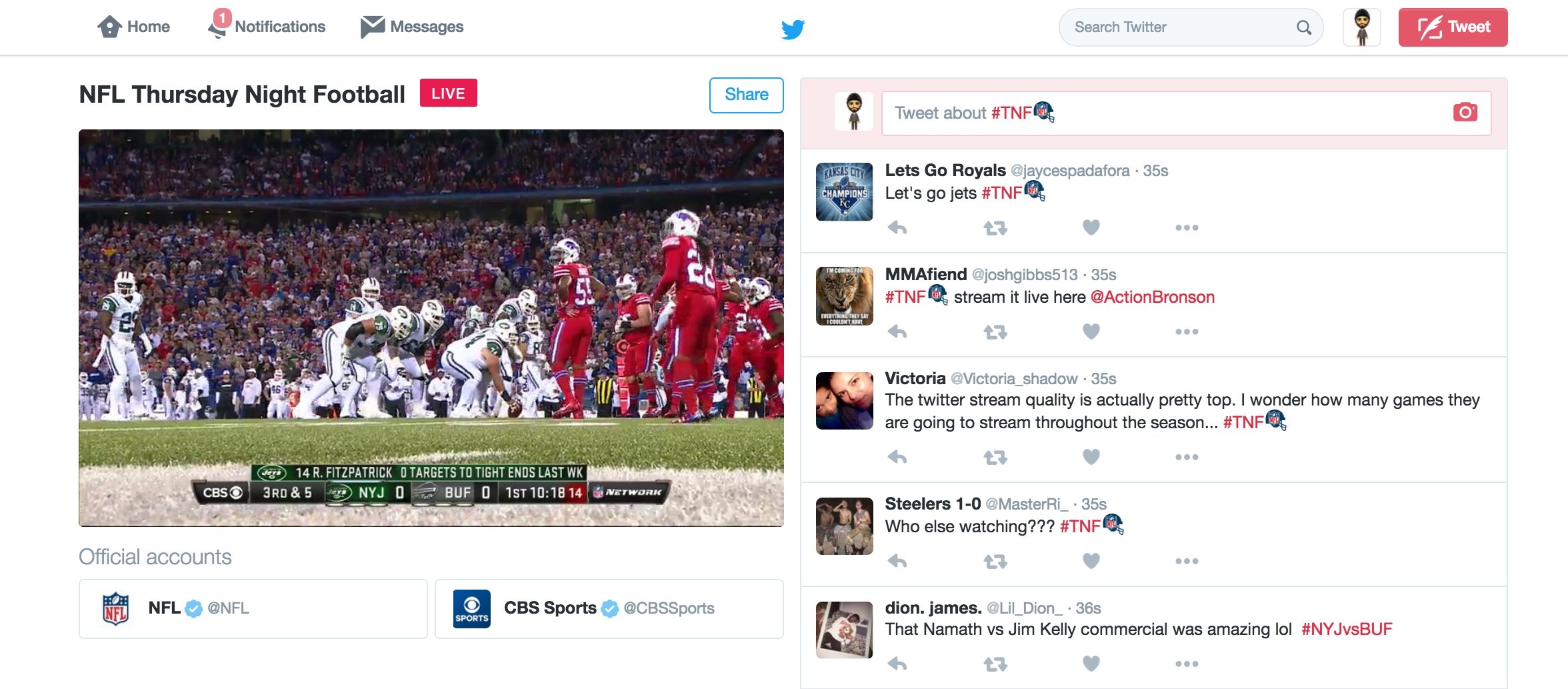
In total, Twitter reached 2.3 million global viewers during both the pregame show and the main attraction, which saw rivals the New York Jets and the Buffalo Bills battle it out. The game alone saw 2.1 million viewers tune in, and the average audience watching Thursday Night Football on Twitter was 243,000.
Although the Twitter numbers did not matching television, which boasted 48 million viewers, the average viewing time between the two formats was fairly close — on TV people tuned in for an average of 25 minutes, whereas on Twitter it was 22 minutes. The engagement numbers will no doubt matter when Twitter starts to beef up its in-stream advertising.
After months of speculation regarding its format, Twitter’s livestream turned out to be a smooth, high-quality transmission offered in the same layout as was presented during its Wimbledon highlights livestream.
Twitter promoted the stream in the form of its very own trending hashtag (which carried a “live” icon for good measure), on its Twitter Sports and Moments accounts, and via Periscope.
On desktops and mobile, the stream was housed inside its own window with a Twitter timeline devoted to Thursday Night Football (#TNF) tweets placed underneath it. Viewers had the option to slightly change the layout by maximizing their browser, which expanded the timeline by placing it next to the stream. A full-screen option allowed you to simply focus on the action and bypass the noise from the Twitter community — closed captions, and a mute button were also included.

The only hiccup viewers encountered was a notification demanding you turn off your ad blocker to watch the stream, and enable cookies if you were using Safari — a small price to pay for the free broadcast. After that, it was smooth sailing.
Having experienced Twitter’s first NFL livestream, it’s evident that the firm’s big gamble is as much (if not more) a play for non-users as it is for existing fans. How else does one explain its decision to make its NFL coverage, which came with a $10 million price tag, available to those without an account on the web, and via its new streaming apps for Apple TV, Xbox One, and Fire TV?
If you happened to watch the game on Twitter, you’ll also have its new ad campaign etched on to your memory. The company’s latest promos emphasizing its live events coverage played throughout the proceedings, hitting home the message until there was no doubt left: Twitter is changing, and “live” is its new brand.
Fortunately for the platform, the feedback was generally positive. In particular, viewers were impressed with the quality of the broadcast and there was a genuine sense of excitement on the timeline. A number of tweets exclaimed that this was the future of Twitter, and others urged the company to show more live content (from awards shows such as the ESPYs to additional sports streams).
The #TNF stream on Twitter is crystal clear. And only a couple seconds behind my TV. Very cool. #NYJvsBUF #NFL pic.twitter.com/zgbtj5FMlR
— Jason Hartelius (@jasonhartelius) September 16, 2016
I don't even watch football, but I will now because it is on Twitter. Incredible quality. #hello future #TNF
— Lee Duncan (@thinkdesign_ld) September 16, 2016
We're really watching Thursday night football live on twitter man this is history in the making. #TNF
— JimmyB (@Eggswitcheese) September 16, 2016
However, the experience wasn’t without its drawbacks. Twitter somehow bumbled its core tweeting function by making it almost impossible to reply to or expand a tweet from the accompanying timeline without interrupting the stream. Additionally, a number of users tweeted about a delay in comparison to the live TV broadcast of anywhere between 2-30 seconds.
A 21 second delay from the TV feed to the Twitter stream. Still awesome! #TNF
— Alex Sandoval (@AlexSandoval_95) September 16, 2016
@eightiethmnt agree reply could be a bit smaller/tighter
— Vikram Taneja (@vikramtaneja) September 16, 2016
The timeline itself was also the subject of much confusion, as active users could not figure out how it was curated — our guess is that it included all the tweets that contained the #TNF hashtag and talk of the game. This resulted in a chaotic feed of random tweets, distracting GIFs, and videos — with barely any exclusive material. Twitter really missed its opportunity to showcase tweets from verified accounts, popular users, and its Periscope commentary from NFL alum Cris Carter. Chances are it will improve upon the feature going forward — although it remains doubtful that it will open up the timeline customization options hardcore users crave.
Can I make the #TNF timeline just be typing something like NFL?
— phenson (@mr_ncs) September 16, 2016
I dig the @NFL on @twitter, but I really want to watch with MY feed – not the hashtag #TNF feed.
— Billy Kulpa (@billykulpa) September 16, 2016
Are the #TNF Tweets curated beyond the obvious filters? Cool for first game, but would get old/boring.
Still, a lot you could do there…
— M.G. Siegler (@mgsiegler) September 16, 2016
Overall, the message from the community was resoundingly in favor of the stream — a sure sign that the company is on to a winner. Despite shrewdly catering its live content strategy around the biggest talking points on its service (sports, news, politics, finance), Twitter isn’t merely trying to increase chatter. Instead, livestreaming represents its latest (and boldest) bid to extract itself from the “social media” label and all the baggage that brings with it regarding the cumbersome pursuit of active users, which isn’t exactly Twitter’s strong point.
On Thursday, Twitter’s future may have materialized before our eyes. It is a future that sees passive spectators and cord-cutters (who will one day be served more than just the company’s own ads during livestreams) sitting alongside its opinionated chatterboxes. And each set of users will be engaging with the site in its own distinct way.


